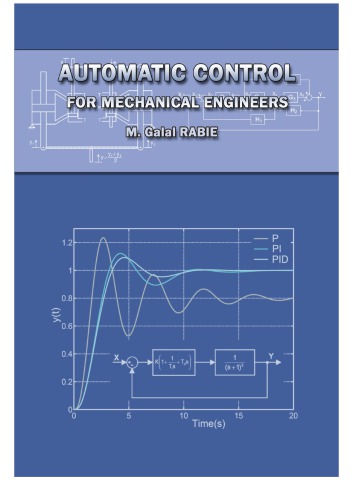

Most ebook files are in PDF format, so you can easily read them using various software such as Foxit Reader or directly on the Google Chrome browser.
Some ebook files are released by publishers in other formats such as .awz, .mobi, .epub, .fb2, etc. You may need to install specific software to read these formats on mobile/PC, such as Calibre.
Please read the tutorial at this link. https://ebooknice.com/page/post?id=faq
We offer FREE conversion to the popular formats you request; however, this may take some time. Therefore, right after payment, please email us, and we will try to provide the service as quickly as possible.
For some exceptional file formats or broken links (if any), please refrain from opening any disputes. Instead, email us first, and we will try to assist within a maximum of 6 hours.
EbookNice Team

Status:
Available0.0
0 reviews
ISBN 10: 9771798693
ISBN 13: 9789771798699
Author: Galal Rabie
Automatic control plays an important role in the advance of engineering and science. It is of extreme importance in most of the engineering fields; such as the aerospace engineering, chemical engineering, robotic systems, automotive and mobile equipment engineering as well as manufacturing and industrial processes. Automatic control provides the means of understanding the problems of stability and precision of dynamic systems. Actually most engineers must have good understanding of this field.
The majority of textbooks on automatic control are most appropriated for electrical engineers. The main problem in designing and analyzing a control loop for non-electrical systems normally arises when deducing adequate mathematical model for the system. Generally, the components cannot readily be represented by simple discrete ideal elements. The classical approach based on the transfer function and associated techniques of analysis is more easily comprehended and related to practice by the beginners than is the modern control theory. Therefore this text is prepared for the mechanical engineering students. It deals with the basics of linear control theory. The text includes simple examples enabling applicants to understand the problems of dynamic systems accuracy and stability. The text includes examples and exercises that facilitate the comprehension of the control theory, especially for the mechanical engineering students. The text is arranged in ten chapters dealing with the following topics:
Chapter 1: Introduction to Automatic Control
1.1 introduction
1.2 system definition
1.3 system control
1.3.1 open loop control
1.3.2 closed loop (feedback) control
1.4 system representation
1.4.1 schematic diagrams
1.4.2 mathematical model
1.4.3 transfer function
1.4.4 block diagram
1.4.5 signal flow graph
1.4.6 state space representation
1.4.7 bond graph
1.5 system analysis
1.6 exercise
Chapter 2: Mathematical Topics
2.1 introduction
2.2 differential equations
2.3 Laplace transform
2.3.1 direct Laplace Transform
2.3.2 inverse Laplace Transform
2.3.3 properties of Laplace Transform
2.3.4 partial fraction expansion
2.3.5 solving differential equations using Laplace Transform
2.4 complex variables
2.5 Laplace Transform tables
2.6 exercise
Chapter 3: Transfer Functions
3.1 basic definitions
3.2 transfer function of some basic elements
3.2.1 proportional element
3.2.2 integrating elements
3.2.2.1 ideal hydraulic cylinder
3.2.2.2 valve controlled actuator
3.2.3 first order element
3.2.3.1 hydraulic servo actuator
3.2.3.2 resistance‑capacitance network
3.2.4 second order element
3.3 exercise
Chapter 4: Block Diagram
4.1 introduction
4.2 conventions for block diagrams
4.3 deducing system transfer function
4.4 block diagram algebra
4.5 exercise
Chapter 5: Signal Flow Graph
5.1 introduction
5.2 conventions for signal flow graphs
5.3 Mason’s formula
5.4 exercise
Chapter 6: Time Domain Analysis
6.1 introduction
6.2 time response of basic elements
6.2.1 integrating member
6.2.1.1 response to step input
6.2.1.2 response to ramp input
6.2.1.3 response to input impulse
6.2.2 first order element
6.2.2.1 step response
6.2.2.2 response to ramp input
6.2.2.3 response to input impulse
6.2.3 second order element
6.2.3.1 step response of second order element
6.2.3.1.1 over‑damped
6.2.3.1.2 critically‑damped
6.2.3.1.3 under‑damped
6.2.3.1.4 undamped
6.2.3.2 response to ramp input
6.2.3.3 response to input impulse
6.2.4 third and higher order systems
6.2.5 effect of root location
6.3 transient response characteristics
6.4 step response testing of practical systems
6.4.1 first order response
6.4.2 under‑damped second order response
6.5 exercise
Chapter 7: Frequency Response
7.1 introduction
7.2 calculation of the frequency response
7.3 polar plot (Nyquist diagram)
7.3.1 polar plot for first order element
7.3.2 second order element
7.3.3 integrating member
7.3.4 higher order elements
7.4 Bode diagram
7.4.1 introduction
7.4.2 bode plot of basic elements
7.4.2.1 proportional element
7.4.2.2 integrating element
7.4.2.3 first order element (simple lag)
7.4.2.4 simple lead element
7.4.2.5 second order element
7.4.2.6 quadratic lead element
7.5 Nichols chart
7.6 exercise
Chapter 8: Feedback System Accuracy and Stability
8.1 introduction
8.2 steady state error
8.2.1 step input
8.2.2 ramp input
8.3 stability of feedback systems
8.3.1 Routh‑Hurwitz criterion
8.3.2 Nyquist criterion
8.3.2.1 via Nyquist plot
8.3.2.2 via Bode plot
8.3.2.3 via Nichols chart
8.4 exercise
Chapter 9: Root Locus Analysis
9.1 introduction
9.2 interpretation of root locus
9.3 exercise
Chapter 10: Compensation of Control Systems
10.1 introduction
10.2 phase lead compensator
10.3 phase lag compensator
10.4 lag‑lead compensator
10.5 P, PI and PID controllers
10.6 exercise
controls mechanical engineering
mechanical controls engineer
automatic control engineering corporation
what is mechanical automation
what is automatic mechanical movement
Tags: Galal Rabie, Automatic Control, mechanical Engineers